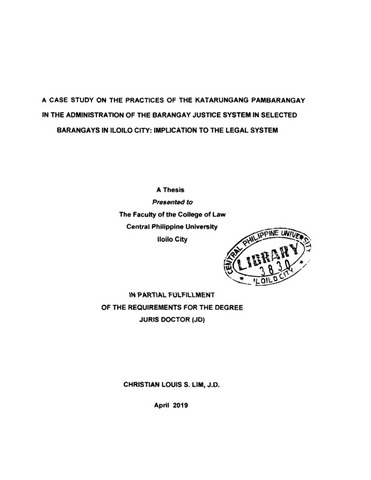A case study on the practices of the Katarungang Pambarangay in the administration of the barangay justice system in selected barangays in Iloilo City: Implication to the legal system
| dc.contributor.adviser | Alibogha, Salex E. | |
| dc.contributor.author | Lim, Christian Louis S. | |
| dc.coverage.spatial | Iloilo | en_US |
| dc.date.accessioned | 2021-07-01T01:50:18Z | |
| dc.date.available | 2021-07-01T01:50:18Z | |
| dc.date.issued | 2019 | |
| dc.identifier.citation | Lim, C. L. S. (2019). A case study on the practices of the Katarungang Pambarangay in the administration of the barangay justice system in selected barangays in Iloilo City: Implication to the legal system (Unpublished postgraduate thesis). Central Philippine University, Jaro, Iloilo City. | en_US |
| dc.identifier.uri | https://hdl.handle.net/20.500.12852/1140 | |
| dc.description | Abstract only | en_US |
| dc.description.abstract | This study was conducted to find out the first hand experiences of Punong Barangays in the implementation of the Katarungang Pambarangay or Barangay Justice System as mandated by Republic Act No. 7160 otherwise known as the Local Government Code of 1991, Katarungang Pambarangay Rules were promulgated by the Department of Justice on June 1, 1992, providing guidelines for the Katarungang Pambarangay. The Katarungang Pambarangay System is intended to improve the access to justice to those who would opt not to go through the traditional, adversarial, and adjudicative litigation in the court and to allow petty disputes arising from the Barangay level to be immediately resolved. It has four-fold benefits: to unclog court dockets, achieve speedy disposition of cases, enhance access to justice, and to involve the community in dispute resolution. The Katarungang Pambarangay System benefits the parties by affording them the discretion to make their own arrangements to resolve their dispute in the Barangay without resorting to filing a case in court. Thus, the Barangay serves as a government unit that not only involves executive and legislative functions but also judicial functions as well. The Appropriate Research Design is a qualitative method based on interviews regarding the experiences of Punong Barangay’s in Jaro, Iloilo City about common practices of the Katarungang Pambarangay and its implication upon the legal system. Results of the interviews, review of related studies and the provisions of the law are examined through a narrative analysis. The design used was qualitative descriptive phenomenology. Saturation point was attained after interviewing five (5) Punong Barangays. Results revealed that parties to the case would only resort to Lupon proceedings as a last resort, in fact in all five of the Punong Barangays interviewed stated that disputes are resolved as discreet as possible so as to avoid reaching the stage wherein Lupon proceedings would now be necessary and would ultimately lead to court proceedings. | en_US |
| dc.format.extent | ii, 53 leaves | en_US |
| dc.language.iso | en | en_US |
| dc.rights | Attribution-NonCommercial-NoDerivs 3.0 Philippines | * |
| dc.rights.uri | http://creativecommons.org/licenses/by-nc-nd/3.0/ph/ | * |
| dc.subject.ddc | Law Library 340.72 L628 2019 | en_US |
| dc.subject.lcsh | Dispute resolution (Law) | en_US |
| dc.subject.lcsh | Local government | en_US |
| dc.subject.lcsh | Justice, Administration of | en_US |
| dc.subject.lcsh | Philippines--Iloilo | en_US |
| dc.title | A case study on the practices of the Katarungang Pambarangay in the administration of the barangay justice system in selected barangays in Iloilo City: Implication to the legal system | en_US |
| dc.type | Thesis | en_US |
| dc.description.bibliographicalreferences | Includes bibliographical references | en_US |
| dc.contributor.chair | Bedona, Zacarias D. Jr. | |
| dc.contributor.department | College of Law | en_US |
| dc.description.degree | Juris Doctor | en_US |
| local.subject | Barangays | en_US |
| local.subject | Katarungang Pambarangay | en_US |
| local.subject | RA 7160 | en_US |
| local.subject | Local Government Code of 1991 | en_US |
이 항목의 파일
This item appears in the following Collection(s)
-
Juris Doctor [144]



